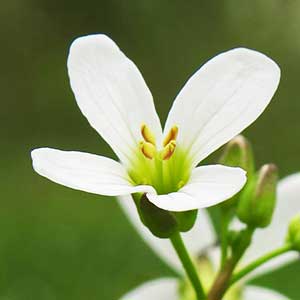Cardamine purpurea
Cardamine penduliflora
purple bittercress
wetlands bitter-cress, Willamette Valley bitter-cress
vertical, 1–3 mm diam., (not fleshy).
(tuberiform, fragile), 4–9(–11) mm diam., (fleshy).
(simple or few to several from base), usually erect, unbranched, (0.3–)0.5–1.2(–1.5) dm.
erect or decumbent at base, unbranched, 2–6(–7.5) dm.
sometimes rosulate, usually 3 or 5-foliolate, rarely simple, (1.5–)2.5–7 cm, leaflets petiolulate or sessile;
petiole (1.2–)2–5 cm;
lateral lobes or leaflets sessile, blade similar to terminal, distinctly smaller;
terminal lobe or leaflet petiolulate (0.05–0.6 cm), blade reniform or suborbicular to broadly ovate, 0.3–1 cm × 4–15 mm, base subcordate to rounded, margins entire, repand, or obscurely 2-toothed.
5–13-foliolate, (4–)10–18(–25) cm, leaflets petiolulate or subsessile;
petiole (3–)5–12(–17) cm;
lateral leaflets subsessile, blade similar to terminal, sometimes smaller;
terminal leaflet (petiolule 0.4–0.7 cm), blade oblong to elliptic or ovate, (0.4–)0.7–1.7(–2) cm, base cuneate or obtuse, margins entire or obscurely 3-lobed.
1–3, usually compound, rarely simple, petiolate, leaflets petiolulate or sessile;
petiole (0.2–)0.5–2 cm, base not auriculate;
similar to basal, smaller.
2–6, 5–11-foliolate, petiolate, leaflets petiolulate or sessile;
petiole 3–10 cm, base not auriculate;
lateral leaflets sessile, blade similar to terminal, smaller;
terminal leaflet (petiolule 0.5–1.5 cm), blade narrowly ovate or oblong to oblanceolate, 1.5–3.5 cm × 2–15 mm, margins entire or toothed to 3-lobed.
ebracteate.
ebracteate.
sepals oblong, 2–3(–4) × 1.4–1.7 mm, lateral pair not saccate basally;
petals usually purple to pink, rarely white, obovate, 5–7(–9) × 3–4(–5) mm, (clawed, apex rounded);
filaments: median pairs 2.5–3.5 mm, lateral pair 1.5–3.5 mm;
anthers oblong, 0.6–0.9 mm.
sepals oblong to ovate, 3.5–5 × 1.8–2.5 mm, lateral pair saccate basally;
petals white, obovate, 12–16 × 6–8 mm, (not clawed, apex rounded or subemarginate);
filaments: median pairs 6–7 mm, lateral pair 4–5 mm;
anthers oblong, 1.5–1.8 mm.
suberect, ascending, or divaricate, 5–12 mm, pubescent.
ascending to divaricate, (10–)20–40(–60) mm.
linear, 1.5–2.5 cm × 1.5–1.8 mm;
ovules 10–14 per ovary;
style 1–2.5 mm.
linear, 2.5–4.5 cm × 1.4–2 mm;
ovules 12–24 per ovary;
style 4–6 mm.
brown, oblong to broadly ovoid, 1.7–2.1 × 1.4–1.7 mm.
brown, oblong, 1.8–2 × 1–1.5 mm.
= 96.
Cardamine purpurea
Cardamine penduliflora
Cardamine penduliflora is known from Douglas County north into Benton, Lane, Marion, Polk, and Yamhill counties.
(Discussion copyrighted by Flora of North America; reprinted with permission.)
